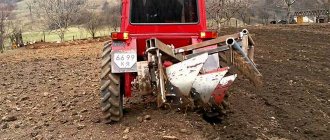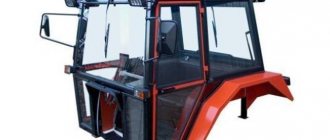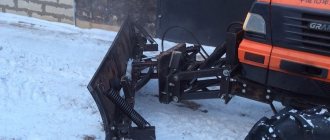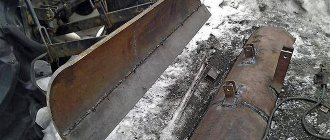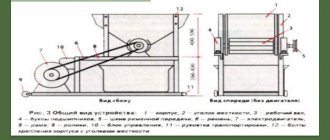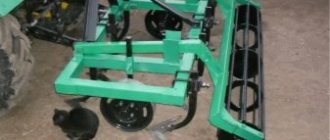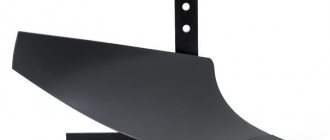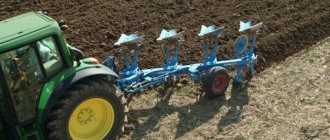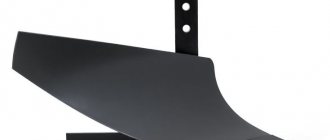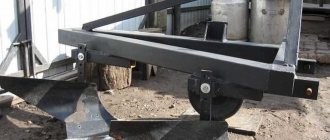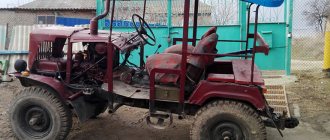A plow is an integral tool in agriculture, which is used to plow the soil using metal moldboards and ploughshares. Often, purchasing a unit for older model tractors is useless due to the inability of hydraulic attachment systems to interact with attachment mounts. The homemade plow on the T-25 is not complex in terms of its body structure. Each farmer can make such a unit on his own.
DIY attachments for the T-25 tractor
There is a large selection of trailed attachments for the T-25 tractor, so we will not only talk about homemade plows. If the user is not able to purchase factory units, then there are several methods of self-assembly. Detailed instructions for making all types of attachments with your own hands, as well as video tutorials, will help you assemble the device correctly and reliably.
Homemade plow
The manufacture of attachments is carried out in several ways. If you do not have special rollers at hand for bending metal sheets, then use simpler manufacturing methods. The plow must withstand heavy loads, so alloy steel with a thickness of at least 3-5 mm, which is protected from corrosion, is used during assembly.
An important part of the unit is the plowshare, which must be made durable, adjustable and removable in order to be able to vary the depth and avoid damage to the structure.
The first case of assembly involves making a blade from a metal pipe with a diameter of 55-60 cm. The thickness of the steel should be at least 0.4 cm. A template for cutting out structural parts from steel is made according to the drawings from thick cardboard. Rollers for bending steel sheets will speed up the manufacturing process. The blanks are cut from cardboard exactly to size and fed onto rollers at an angle of 20°. After bending, the structural parts are easily brought to the desired shape with a hammer on an anvil.
The second method is labor-intensive and does not involve the use of rollers. The blank for the dump is heated in the forge for subsequent processing. Here it is preferable to use a ready-made blade from old equipment for the T-25. The cut templates are applied to the blade at an angle of 20°, preliminary marking is carried out with chalk on a surface sanded. Otherwise, the process repeats the first method, and a gas welding machine is used to cut out parts.
Welding work is carried out by fastening the plowshares with the blade and the metal sheet under which the shield is placed. The blades of the share must be at the correct angle, as well as the top edge. To connect the parts of the plow structure together, welding is also performed. In order for the plow to hold the furrow, its design includes a wheel unit, the height and angle of which are varied by a bushing with a notch. The diameter of the wheel must be at least 20 cm. This process is discussed in more detail in training videos for homemade plow making.
After assembly and minor adjustments, the plow should work properly if you have maintained the correct angle of the plowshares relative to the location of the blade.
DIY potato digger
Making a potato digger for the T-25 tractor is a less labor-intensive process than assembling a plow, but is carried out strictly according to the diagrams. The mechanism of its operation is simple: the ploughshare opens the soil, the elevator grabs the tubers, passes them along the grate, clearing them of soil, and dumps the peeled fruits.
The frame of the unit is made of metal sheets, which are best connected not by fasteners, but by welding. The elevator casing is installed on the frame and secured through holes that need to be drilled. When attaching to the frame, it is important to use bolts that will allow you to change the angle of inclination of the elevator and the plowshare with which it will be attached. The ploughshare is made of thick alloy steel and is shaped like a bucket, the corners of which must be rounded.
The manufacture of the digger drive is carried out using gears, hubs and shafts. The mechanism is quite simple; at this stage it is important to follow the assembly algorithm described in the diagram. A more complex design is the cleaning drum, consisting of two chains that are strung on steel pins and fastened with metal sheets. This mechanism is driven by a shaft. The connection to the T-25 shaft is carried out using a structure with a shaft, bearing and pin.
Homemade coon
On the T-25 tractor it is possible to install a front factory load of no more than 200 kg with a low load capacity, since the design of the tractor cannot withstand heavy loads. There are few examples of assembling a homemade kun, since experienced users note a high risk when using homemade structures, especially those with a large weight.
DIY cutter
The answer to the question of how to make a cutter yourself is simple. The body of a homemade cutter is made of steel sheets 1 cm thick and a 12 U channel. The main unit is a gearbox and a transmission connection, which can be used as a ready-made unit from a similar old device; there are options, for example, a bridge from a Zhiguli car. The side mechanism is assembled using oiled gears.
Knives for the cutter are made from durable thick metal and are cut according to a template using a gas welding machine. After sharpening on a machine and sanding, the knives are attached to the shaft. The connection to the body and PTO is carried out through a bearing mechanism and bolted fastening.
Cultivator
When making a homemade cultivator, it is important to choose materials that do not corrode, so that the moisture present in the soil does not oxidize the frame. To make a three-row frame, thick steel pipes or channels are used. Hinges are attached to the drive beam, which will allow the cultivator blades to move correctly smoothly - this will allow you to vary the depth of immersion of the blades into the ground and will not allow the mounted cultivator to get stuck in the soil.
An important point is the manufacture and fastening of sickle-shaped paws with knives that loosen the soil. They are made of stainless materials, and their elements are fastened together by welding. The floating mechanism of the knives is adjusted by a spring mechanism, for example, from an old seeder: for each knife there must be a separate spring with the required level of tension.
It is better to make the drive wheels made of metal and make them wide. This will allow them not to get stuck in the soil and act as rollers or a press that compacts loosened soil. If necessary, standard harrows are attached to the body on chains behind the cultivator's paws, which will provide additional loosening of the soil.
Shovel
There are many options and drawings for making a shovel for the T-25. Most often, for homemade attachments, cross sections of thick, large-diameter pipes are used, which have the required bend and all that remains to be done is to bring the shape of the shovel to the desired size and assemble a simple attachment mechanism.
To make a shovel, a steel sheet can be given the desired shape by heating or using rollers. Material with an anti-corrosion coating is taken so that the attachments last longer.
Mounted loader
Unlike the front suspension, homemade rear suspension structures for the T-25 are common. Some design options can be complex, so during manufacturing it is necessary to clearly focus on the rear loader assembly diagrams. The ladle can have various shapes, but must be made of thick steel. This will help avoid premature deformation of the fastening elements and the bucket itself during operation. The main difficulties during assembly arise in the manufacture of the hanging frame.
The most common type of fastening is a V-shaped inverted hydraulic frame with a movable unit at its top. Compared to other types of mounted loader, it is simple to manufacture and provides variable lifting stroke, but when lifting heavy loads, the user may have problems due to the large travel radius of the bucket. For manufacturing, thick steel blanks and channels are used that can withstand sufficient load. The elements are fastened with strong welding.
To control the stroke of a homemade loader bucket, factory retractable hydraulic cylinders of appropriate power are most often used, which are connected to the tractor’s hydraulic linkage system via oil hoses.
Do-it-yourself blade
The shape of the blade located at the front, as well as the rear shovel, can be different. The principle of making the shovel itself is simple, but the main attention should be paid to the correct fastening and supports that can withstand the load and not break the tractor frame.
Hydraulic control of the blade is provided by a factory extendable cylinder, which can be borrowed from almost any old attachment. It is mounted in the front of the tractor. To do this, metal plates with a through hole are welded to the front frame beam, and a cylinder socket is attached between them. The same plates act as fastenings on the blade itself.
2 support beams are mounted at the bottom of the blade and in the middle of the tractor frame. To do this, thick plates located perpendicularly are welded to the frame. Through through holes, support beams are attached to pulleys and do not allow the blade to move freely, controlling its progress.
Rotary cutter
The rotary tiller has a complex design, so it is convenient to take the gearbox from the popular PK-1.6 stacker as a basis. The side mechanism is easier to assemble and is made from parts of passenger cars. The gearbox with the transmission mechanism should be mounted on a square frame welded from thick channels, and in the lower part there should be a shaft with knives, for the manufacture of which springs from KAMAZ are suitable. Knives must be sharpened on a machine to achieve a good loosening effect.
Ladle
The bucket is a universal tool that is easy to assemble and fasten. There are several drawings for making buckets of different shapes. For manufacturing it is necessary to use thick steel that is resistant to deformation.
How to make a hiller
For manufacturing you will need a channel and a small supply of thick steel. According to the drawing, a V-shaped structure, shaped like a double plowshare, is attached or welded to the sickle-shaped share. At the point where the hiller blades converge, a baking powder is additionally installed.
Bulldozer
The principle of mounting a bulldozer on the front of a tractor is similar to mounting a blade. Remember that if you are going to make a large working part of a bulldozer, you must increase the strength of the support beams and use a powerful hydraulic cylinder.
Potato planter
A potato planter is the most difficult unit to assemble yourself, but there are many video tutorials and drawing options that will help you understand the complex manufacturing process.
Making a bucket yourself
Purchasing a multifunctional unit is not always available due to the high price. Therefore, among the owners of their own tractors and farmers there are always technically savvy people who know how to make a kun on the T-25 with their own hands. The work seems difficult only at first glance. However, you need to carefully prepare for the manufacture of the unit. To achieve a good result, it is necessary to carry out preparatory work on drawing up drawings and collecting the necessary parts, since the final result of making the kun will depend on this.
- When producing workpieces, you need to use gas cutting of metals, which allows you to create clean welding, which is extremely important during the assembly of the kun.
- The power of the device should be enough for high-quality welding of structural elements.
- The thickness of the metal sheets for the kun must be selected individually, based on the weight of the future attachments and the dimensions of the tractor.
When performing the unit yourself, you need to adhere to this ratio. If the weight and dimensions of the equipment are too large, the tractor may lose balance due to a violation of the proportions between them. Therefore, when manufacturing a mounted unit, it is important to be guided by a well-drawn drawing and exact dimensions.
Kuna drawing sample
About materials and tools
Before you make a kun on the T-25 with your own hands, you need to select the necessary materials and tools that may be needed.
In order for the bucket to be made correctly, the owner of the agricultural machine will need the following materials:
- metal sheets with dimensions corresponding to the size of the tractor that will be equipped with this unit;
- 4 hydraulic cylinders;
- parts for connecting parts of the structure (nuts, bolts).
This set of materials is enough to make equipment.
To make a high-quality kuna, the master needs to stock up on a set of tools:
- grinder;
- wrenches;
- drill;
- screwdrivers;
- welding machine;
- pliers.
Kuna sizes
To implement this unit, you must comply with the dimensions of the T-25 kun, provided for in the drawing, which is drawn up according to the dimensions of the tractor. They must reflect the dimensions of all parts and the sequence of fastenings.
Independent production of a reliable bucket will require the craftsman to strictly adhere to all the dimensions contained in the drawings of the kun for the T-25. This is a guarantee that the equipment in terms of dimensions and dimensions corresponds to the technical characteristics of the agricultural machine. Where the coon will be placed (behind or in front) will be decided by its owner. The main condition is that the length of the boom on which the kun will be placed does not exceed 2 m . If this dimension is not observed, the tractor may lose balance.
Kuna production occurs in a certain order
Homemade hitch
To make a simple rear hitch, you will need channels 10 cm thick, connecting beams and coupling devices from any small tractor. Holes are cut in the channels to allow them to be attached to the tractor frame. After this, the crossbars are pulled together by coupling devices crosswise and hung on the connecting beam. It is necessary to cut holes at the opposite end of the channels. They will allow you to attach a trailer or hitch for attachments to the hitch.
DIY cabin
For the manufacture of the cabin frame, the best material is a profile pipe to which the glass seal is attached. The dimensions of the glass pattern are determined by the size of the cabin and the thickness of the seal. It is best to use chipboard sheets as a template, which will allow you to most accurately select the desired size.
To fix the seals, thin steel strips are used, which are welded to the supporting pillars of the cabin frame. The cabin structure is welded separately, in parts, and then assembled into a single structure. Corner beams must be made of durable material that is not subject to deformation when shaking. After the cabin body is welded, you can begin cutting out the glass and glazing itself. To install the stove, it is necessary to additionally insulate and seal the tractor cabin.
Stove for tractor
Air heating in the T-25 cabin is done by many amateurs. The main heating element will be a cooling fan, from which a tube is passed into the cabin, which will pump warm air. It is important to insulate the tube with sealant at both ends so that the efficiency of the homemade stove increases. This will prevent exhaust gases from entering the cabin. The on and off function can be adjusted by installing the damper from the stove of any passenger car.
DIY trailer
The single-axle cart design for the T-25 tractor is the most suitable option. The average weight of the standard design is 800 kg, which will allow it to transport loads up to 2 tons. The cart frame is made by welding spars at least 10 cm thick. A complete axle of a small tractor can be used as an axle and wheels for the cart.
To equip the trailer with a blade option, it is necessary to reinforce the frame with a beam in the middle part. A socket is welded to the beam for installing a cylinder, which will be responsible for the dump of the body, and a reinforced support for installation. The hydraulic cylinder most suitable for a small-sized cart blade is PTS-9. The maximum output of the cylinder is 85 centimeters, which will allow the body platform to become at an angle of 50 °.
Description and purpose of kuna
A universal mounted bucket performs loading work. With its help, hard labor is replaced with automated work. The T-25 tractor with a kun easily copes with large volumes of lumpy or bulk materials for transportation from one place to another:
- snow;
- clay;
- sand;
- crushed stone;
- hay;
- organic fertilizers.
Kun is a necessary piece of equipment for a tractor.
It is actively used in the automation of soil leveling in public utilities and agriculture, cleaning waste for removal, and landscaping. The unit has many advantages. Some of the main ones are:
- Significant reduction in the cost of equipment compared to the factory equivalent. The owner of the tractor will receive great savings during the operation of the kuna, with the help of which he will not need to pay for a large number of different types of work.
- The advantage of the unit is its versatility. Made independently, it is used with many types of agricultural machinery.
The ladle is made with affordable tools available in every home. It is easy to operate and maintain.
